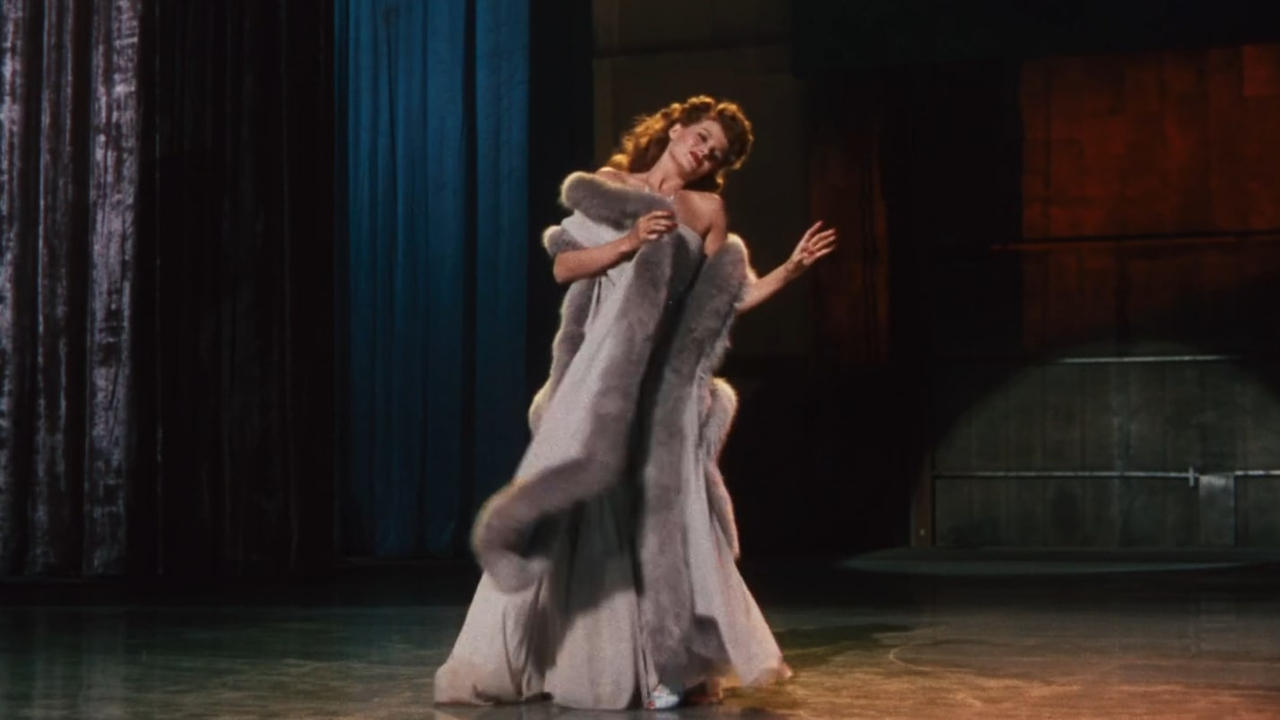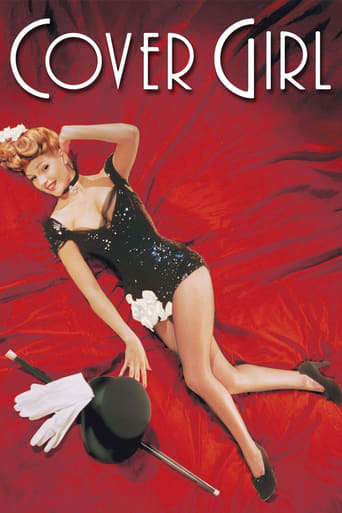

Excellent, Without a doubt!!
... View MoreIt is neither dumb nor smart enough to be fun, and spends way too much time with its boring human characters.
... View MoreThe movie really just wants to entertain people.
... View MoreThere's no way I can possibly love it entirely but I just think its ridiculously bad, but enjoyable at the same time.
... View MoreRita Hayworth plays two characters and the title role in this musical comedy which won an Academy Award for Best Musical Score; the film also received Oscar nominations for its Color Art Direction-Interior Decoration, Cinematography and Sound; its Jerome Kern-Ira Gershwin original song "Long Ago and Far Away" was also nominated. It was directed by Charles Vidor, with a story by Erwin Gelsey and a screenplay by Virginia Van Upp; Marion Parsonnet and Paul Gangelin wrote the adaptation.Hayworth plays chorus girl singer-dancer Rusty Parker (and her grandmother Maribelle Hicks in flashback) opposite Brooklyn club owner and fellow performer Danny McGuire, played by Gene Kelly. Phil Silvers plays Genius, the third wheel and comedian in the trio that's struggling to make it big; they spend every Friday night at Joe's (Edward Brophy, uncredited) bar hoping to find a pearl in an oyster. When Rusty hears fellow chorus girl Maurine Martin (Leslie Brooks) discussing her dream to "get out of this dump and become famous" by auditioning for Vanity magazine's cover, she too decides to give it a try. But Maurine intentionally gives her some bad advice such that Rusty blows her chance with the fashion magazine's Cornelia 'Stonewall' Jackson (Eve Arden). Model Jinx Falkenburg appears briefly, as herself. Otto Kruger plays Vanity's owner, John Coudair; Jess Barker plays Coudair opposite Hayworth's character in the flashback sequences.Cornelia and Coudair go to McGuire's club one night to take another look at Maurine and he "discovers" Rusty, who bears a remarkable resemblance to his first love, singer-dancer Maribelle Hicks (Hayworth again), who'd left him at the altar for a piano player. Coudair puts Rusty on the next cover of his magazine and suddenly McGuire's Brooklyn club is all the rage. When Cornelia and Coudair take Broadway producer Noel Wheaton (Lee Bowman) to the club, he falls head over heals for Rusty and Coudair is only too happy to facilitate their introductions. Wheaton sends her flowers every day (via Billy Benedict's uncredited delivery boy) and, with Coudair's help, manages to sign her for his Broadway show. Naturally, this jeopardizes Rusty's relationship with Danny, whose jealously causes him to exacerbate the situation. Kelly performs a remarkable Stanley Donen-choreographed dance routine with (a ghost-like double exposure version of) himself. Danny and Genius enter military service - there's a war going on - while Rusty stars in Wheaton's show and drinks to salve her lost love. She walks down the aisle with Wheaton just like her grandmother had with Coudair, jilts him just the same, and returns to Danny at Joe's, where Genius joins and the three of them happily dance to the end, together again.
... View MoreSo the message of this movie is stay with the person you truly love because he doesn't want you to become a famous Broadway star because he'll never be one. Huh? Even though you're in the entertainment business don't have any ambition . Why do the three of them wish for an oyster then? Rita Hayworth is the only reason to watch this movie. She's outrageously beautiful, charming, and my favorite female dancer. She moves beautifully and is very underrated as a dancer.imho. Kelly except for the dance he does with himself (yes that's right) is pretty wasted in a role as jealous schmuck who seemingly has no ambition other than running his Brooklyn show. Plus there's the always annoying kvetching of Phil Silvers. Fast forward to Rita's dance numbers and forget the rest.
... View MoreI know it has Gene Kelly in it. I know it has Rita Hayworth in it. I know Phil Silvers provides comic relief and Jerome Kern wrote the songs and Ira Gershwin wrote the lyrics, but I've tried several times to get my appreciative apparatus wrapped around this movie and can't do it.Kern has provided a terrific, soaring tune, "Long Ago and Far Away," which doesn't involve a dance, and the others are without distinction. I mean, the guy composed like nobody else. For "Roberta" he wrote, among other tunes, "Dearly Beloved" and "I'm Old Fashioned", icons in the Great American Songbook. Except for "Long Ago and Far Away," there's nothing like that here.Gene Kelly oozes an easy-going charm but his athletic dancing here still looks like it came out of vaudeville, his arms held out at an awkward angle. He would improve quantumly over the next few years. Rita Hayworth is gorgeous but is stuck in a corny part in a corny plot.Corniness, in the sense of reflecting old-fashioned values, isn't bad per se. I don't think there's anything more juvenile than the story behind "On The Town." But the book means a lot. If the story behind the numbers isn't engaging, it's difficult for the numbers to succeed. Not "impossible" -- look at Fred and Ginger's best -- but difficult.Unquestionably, one of the reasons for the evidently undying popularity of "Singin' In The Rain" is that it's funny as hell, quite aside from the numbers themselves -- which are also light-hearted and well integrated into the plot. "Singin' In The Rain" makes a viewer feel HAPPY in a way that this film simply doesn't. Who wants to see unhappy singers and dancers? I'll tell you who wants to watch unhappy musicals. Opera fans, that's who! There's not a somber moment in "Singin' In The Rain", no serious conflict at all. The more somber a musical film gets, the less entertaining it is. "An American in Paris" was much more ambitious but memorable mostly for its expensive sets. Then there is the dismal "It's Always Fair Weather." I'd like to recommend this because nobody is better at projecting a kind of flamboyant joy than Gene Kelly. That smile belongs in a toothpaste commercial. But, really, "Cover Girl" isn't much more than routine.
... View MoreCover Girl (Charles Vidor, 1944) is worth it for the dancing - much of it choreographed by co-star Gene Kelly, in just his fourth musical. Rita Hayworth is a stage-star who spies a path to the big-time via a magazine beauty competition. Though she gets the gig, thanks to the sentimentality of a big shot who once dated her grandmother, it puts a strain on her relationship with boyfriend and former boss Kelly. That hackneyed but involving plot, which borrows from the Jessie Matthews musical Evergreen, is a springboard for some very interesting routines. The lovely Make Way for Tomorrow sees Hayworth, Kelly and comic foil Phil Silvers dashing around a vast set, arm-in-arm, while the ebullient Put Me to the Test is an energetic stage-set number teaming Gene with a succession of partners. The absolute highlight is Kelly's Alter-Ego Dance, in which he hoofs opposite a transparent version of himself. Until you've seen the screen's second greatest dancer leap over his own head, you haven't really lived. Elsewhere, the staging is just peculiar. During the title number, Hayworth descends the biggest staircase this side of The Great Ziegfeld. When she gets to the bottom, she just sort of waves her arms around a bit. I take it Kelly didn't devise that dance. Poor John, dubbed by Martha Mears, as were all Hayworth's numbers, features the oddest (Cockney?!) accent I've ever heard. The choreography and costumes are almost as weird.Cover Girl is too spotty and muddled to be ranked with the best musicals of the period, but it's a valuable snapshot of one of cinema's greatest creative forces at an important stage in his career. In the film's key numbers, Kelly's sense of ambition is already much in evidence - though it was only once he was given bigger budgets and more significant talents to work with that he really came into his own. Even so, he reportedly cited the Alter-Ego Dance as the most difficult routine he'd ever crafted, and it is a phenomenal achievement*. Hayworth, who Fred Astaire regarded as the best of his own partners, is good value in the lead, and displays a depth of emotion that transcends the slightly stale script, while Phil Silvers and especially Eve Arden provide exemplary comic support. Silvers - later TV's Sgt Ernie Bilko, of course - even does a couple of song-and-dance bits.*Trivia note: Fred Astaire would offer his own variation on the routine two years later - Puttin' on the Ritz - backed by no fewer than nine Astaires. The way Kelly and Astaire pushed one another to ever greater heights during this period is exhilarating.
... View More